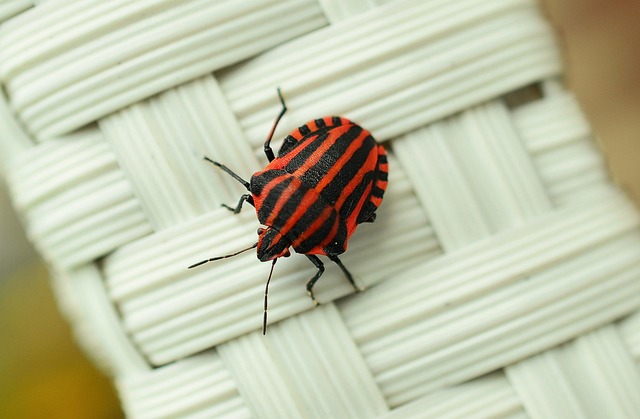Pillbugs, despite their name, are centipedes preferring damp, cool environments; they feed on decaying plant matter and can cause fabric and plant damage. Treatment involves understanding their behavior, preventing moisture, sealing entry points, regular cleaning, and using natural deterrents like neem oil and diatomaceous earth. Regular inspections and addressing moisture issues are key to early identification and effective pillbug infestation treatment. Maintaining excellent hygiene and sealing cracks further prevent future infestations.
Pillbugs, or armadillos, can turn your garden and home into a chaotic mess. This article guides you through creating unfavorable conditions for these pests to thrive. We’ll delve into their behavior, identify signs of an infestation, explore natural treatment methods, and provide preventative measures to ensure your space remains pillbug-free. Learn effective strategies to combat and prevent pillbug infestations with our comprehensive guide on pillbug infestation treatment.
Understanding Pillbugs: Behavior and Habitat
Pillbugs, scientifically known as Armadillidium species, are small, wingless insects that belong to the centipede family. Despite their name, they are not bugs but are characterized by a hard exoskeleton and a segment-like body structure resembling a pill (hence the name). These creatures are nocturnal and prefer damp, cool environments, making them common in gardens, basements, and other humid areas. They feed on decaying plant matter, fungi, and algae, playing a role in decomposition. However, when their preferred habitats become scarce or conditions unfavorable, they can turn to alternative food sources, including stored foods, which is when an infestation may occur.
Understanding pillbug behavior is crucial for effective treatment. They are known to seek shelter in dark, moist places during the day and become active at night. In terms of habitat, they thrive in environments with high humidity and limited sunlight. To prevent and control a pillbug infestation, it’s essential to reduce moisture levels, eliminate potential food sources, and create drier, brighter living spaces, especially in areas prone to these insects’ presence. This can be achieved through proper ventilation, sealing entry points, regular cleaning, and maintaining optimal environmental conditions, all of which are key components of pillbug infestation treatment.
Identifying Signs of Pillbug Infestation
If you suspect a pillbug infestation, it’s crucial to identify signs early on for effective pillbug infestation treatment. Keep an eye out for telltale signs such as small, oval-shaped bugs moving slowly across surfaces or tiny holes in fabric and plant material. Pillbugs prefer damp environments, so look for areas with moisture issues, like under objects that collect water or in poorly ventilated spaces.
Regular inspections of susceptible areas, including basements, garages, and outdoor plants, can help you catch the problem early. If left untreated, pillbugs can quickly multiply and cause significant damage to fabrics, carpets, and garden plants. Recognizing these indicators is the first step towards creating an environment that discourages pillbug activity and promotes a healthier living or gardening space.
Natural and Effective Treatment Methods
Pillbugs, also known as armadillos, can quickly transform a garden or home into a chaotic scene with their persistent chewing. Thankfully, there are several natural and effective treatment methods to combat this common infestation. One of the most straightforward approaches is to maintain excellent hygiene practices, especially in areas prone to moisture buildup. Regularly cleaning and drying damp spaces, such as basements, crawl spaces, and plant pots, can significantly reduce pillbug habitats.
Another powerful tool in your arsenal is using neem oil or diatomaceous earth. Neem oil disrupts the life cycle of pillbugs by impairing their growth and reproduction while being safe for use around pets and children. Diatomaceous earth, on the other hand, dehydrates pillbugs upon contact, making it an effective and environmentally friendly option. These natural treatments not only target existing infestations but also deter future pillbug activity, offering a lasting solution to your pillbug infestation treatment needs.
Preventative Measures to Avoid Future Infestations
To prevent future pillbug infestations, start by addressing potential entry points into your home or property. Pillbugs are known to seek shelter in dark, moist areas, so ensuring your space is well-ventilated and free from excess moisture can deter them. Regularly inspect for any cracks or gaps around windows, doors, or other openings, sealing them with caulk or weatherstripping. Additionally, maintaining a clean environment, especially in kitchens and areas where food is stored, is crucial. Clean up spilled foods immediately, vacuum regularly to remove loose debris, and avoid leaving dirty dishes out overnight.
Implementing these preventative measures will not only help control existing pillbug populations but also serve as effective long-term strategies for pillbug infestation treatment. By making your environment less hospitable, you reduce the likelihood of future infestations, allowing you to enjoy a pest-free living space.
Pillbugs, though seemingly harmless, can cause significant damage to gardens and landscapes. By understanding their behavior, identifying signs early, and employing natural treatment methods combined with preventative measures, homeowners can effectively create unfavorable conditions for these creatures. Implementing these strategies is key to managing and preventing pillbug infestations, ensuring a peaceful and pest-free environment. For effective pillbug infestation treatment, a multi-pronged approach using organic solutions and careful prevention is the best course of action.
